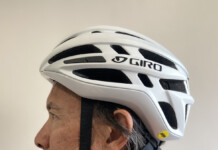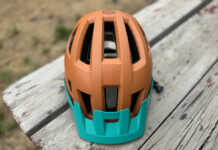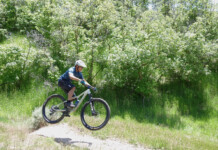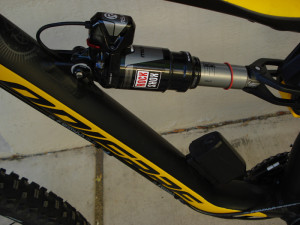
By Tom Jow
A couple months ago I presented an overview of three electronically controlled mountain bike suspension systems. They are the eLect fork lockout system by Magura, Fox Racing Shox’s iCD front and rear lockout system and the E:i electronic intelligence system by Lapierre and RockShox. These three systems represent the future of mountain bike suspension technology. This spring I have had the opportunity to test Lapierre’s E:i suspension system on their Zesty 427 all mountain category bike.
What is it?
The E:i electronic intelligence suspension is a joint project between Lapierre and RockShox which has created a rear shock lockout that opens and closes depending upon the roughness of the terrain being traveled over. The E:i system consists of a battery, two accelerometers, a cadence sensor and a computer. A small servo motor mounted on the rear shock, controlled by the computer opens and closes the rear shock. There are four suspension operating modes: automatic, open, medium and locked. The basic function of the automatic mode is two-fold; locked while pedaling on smooth ground and open when coasting. When pedaling over rough terrain the computer receives signals from the accelerometers and opens the rear shock halfway for small and medium size bumps; all the way for big hits.
Out on the Trail
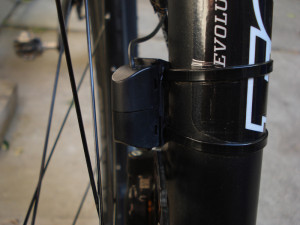
in response to the terrain.
Going into my first few rides I had high hopes for Lapierre’s E:i system. It did not disappoint. When pedaling on smooth trail the rear suspension was firm. I could pedal as hard as I wanted, standing or sitting and there no suspension movement. Pedaling over rough terrain the rear shock opened to do its job with just the buzz of the servo motor. Any time I stopped pedaling, the motor again buzzed when it unlocked the shock. There was no fumbling with a lockout lever when transitioning from climbing to descending. While effective at higher speeds, it felt like its ability to dampen bumps while on slower and more technical climbs was suspect. I liked the fact that the suspension was firm when attacking ledges but riding over a small section of rocks on an otherwise smooth climb, sometimes the shock did not open when I thought it should have. That was, until, I spent a little more time tuning the front suspension.
The basis of the E:i system is sensing of movement by the two accelerometers, one on the lower fork leg and one in the computer head. When the accelerometers are moving upward, the computer interprets that as a bump and opens the shock. Therefore, the rear suspension may open too often if the fork is soft, or in my case, not often enough because it was too firm. The accelerometer in the computer head will also sense if it is moving downward, as in too much action while sprinting. In this case the shock will be kept locked. So after softening the fork pressure the rear suspension felt more effective in those small rock sections while remaining locked out of the saddle.
The Modes
Riding in the manual modes there were no surprises. The locked position is about 95 percent locked, typical of most rear shocks nowadays. There is no perceptible compression while sitting or standing. The open mode was a little soft for climbing. Spinning up the hill smoothly while seated was efficient enough and comfortable but any attempt at standing up resulted in energy absorbing compression. The medium mode is a good balance of firmness for pedaling and compliant suspension.
The automatic mode consists of 5 levels of sensitivity. Automatic 2 was the factory set mode upon delivery and it seemed to operate well. Setting 1 is the most sensitive level. While climbing and riding on all types of terrain the bike was very efficient and comfortable. When sprinting up a short hill with the fork open I found it to be a little too soft, the fork movement caused by pedaling unlocked the rear shock a little prematurely. This is something I did not experience in setting 2. I also tested out automatic 4, the second least sensitive mode. This setting is quite firm. Sections of trail that were comfortable in mode one or two were now a little harsh. A significant increase in speed or force was was now required to get the rear shock to open. The firmer setting seemed like it would be ideal for racing, where the speeds are high and maximum efficiency is paramount.
Conclusions
In just a brief period of riding Lapierre’s E:i suspension, I think it is close to a home run. The automatic mode operates seamlessly and efficiently. During longer rides over varied terrain I could be confident that it would provide the most efficient mode for climbing while having full, open suspension on the descents. Suspension was always there when needed. With five automatic sensitivity levels there is a selection to suit nearly every rider and riding style.
The E:i system is not without drawbacks. One, it has a battery that needs to be charged. Lapierre claims 25 hours on a full charge and in approximately 15 hours of use the battery indicator has diminished by one of three bars. What is the lifetime of the battery? Another electronic quirk I experienced a couple times was a brief disconnect between the computer and the system. It was quickly remedied by removing the computer head and reinstalling it, firmly. Also, I find the wire to the control switch to be a little short, unable to reach a position next to the left handlebar grip, much less long enough for placement on the right side.
All in all the E:i system, even in it’s first year is hard to beat. For racing, I think it is a no-brainer. The suspension is always locked until the going gets rough. For the recreational rider, there may be some question over whether it is really necessary. Consider this: most cross country “fun” bikes have five inches of suspension travel or more, and riders are constantly fiddling with a lockout lever to obtain the best suspension for up or down. Many times that switch is forgotten, having a significant effect on ride quality. Fact: electronically controlled suspension is here to stay and it will only continue to improve. Doesn’t it seem like an automatic system might be a good thing?
Disclaimer: The 2104 Lapierre Zesty 427 as tested was purchased, unprompted with my own money ( albeit at a discount).
Got a bike question? Email Tom at 1tomjow@gmail.com.

